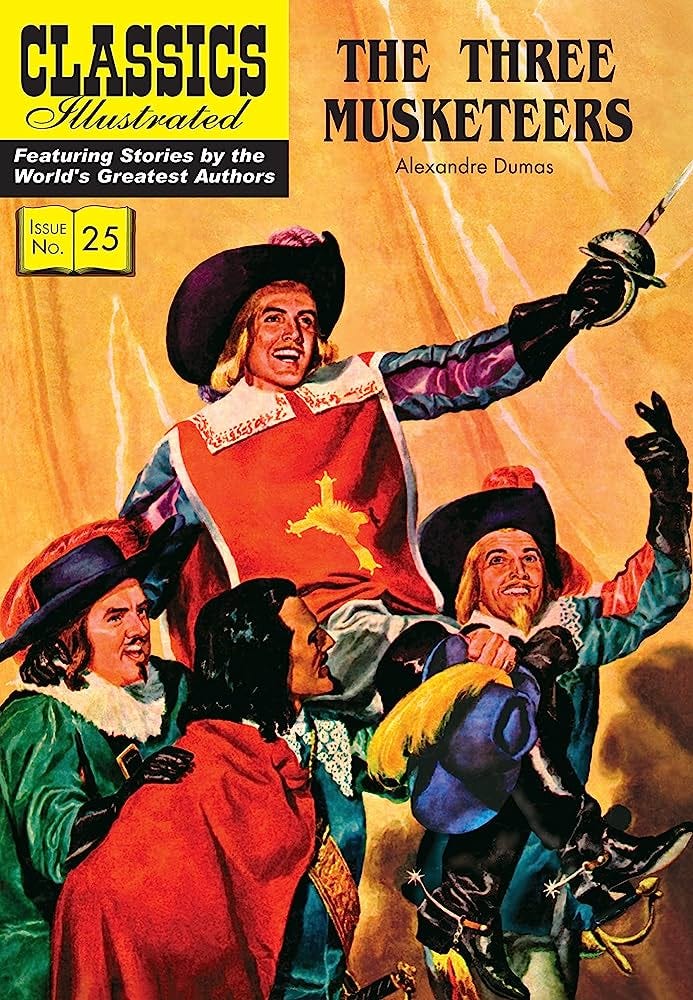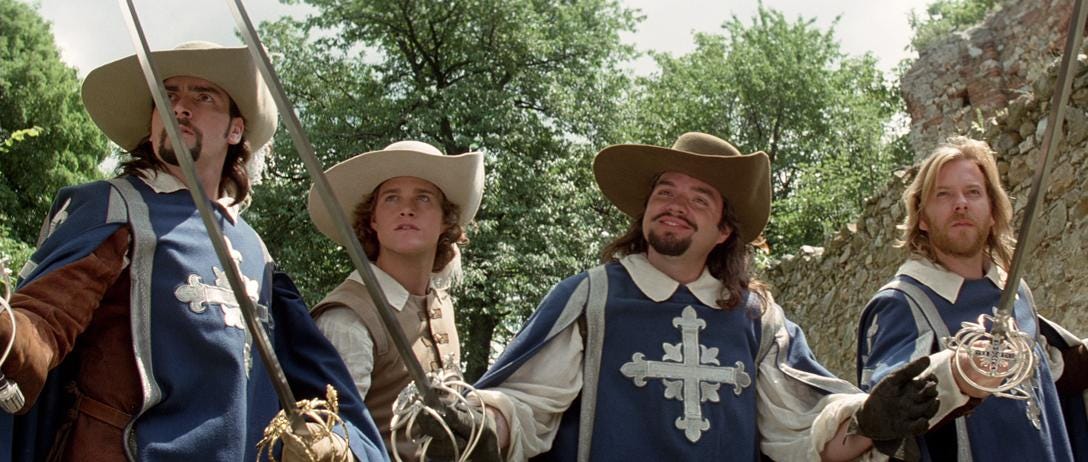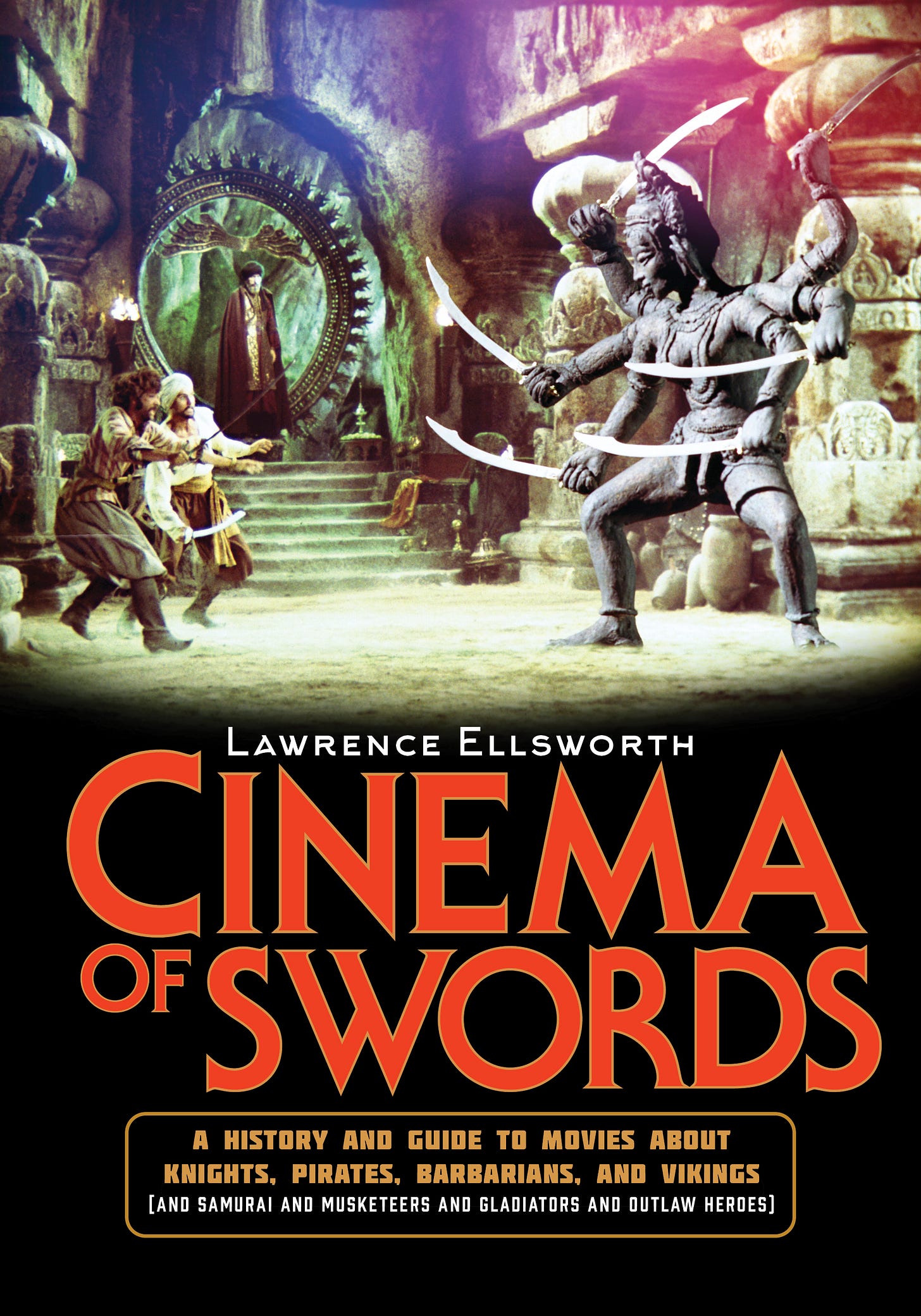Cinema of Swords
A Popular Guide to Movies about Knights, Pirates, Samurai, and Vikings (And Barbarians, Musketeers, Gladiators, and Outlaw Heroes)
By Lawrence Ellsworth
Welcome to the Cinema of Swords Substack! This series is a companion and expansion to my Cinema of Swords hardcover (Applause Books, 2023), which collects over 400 tasty mini-reviews of screen swashbucklers from the Silent Era through The Princess Bride.
This Substack builds on that foundation, continuing forward with reviews of swordplay movies and TV shows from the ‘90s to the present. Every week I’ll present two to four illustrated reviews on a common theme written both to inform and to entertain.
If you enjoyed the contents of the book, this weekly series will give you plenty more of the same. (And if you haven’t seen the book, look for it from wherever you do your book shopping!)
Classics Illustrated
When I was a youth, the newsstands of America were crowded with a monthly profusion of colorful comic books, lurid adventures our parents mostly disapproved of. But if you were in need of a hit of four-color serial stories and couldn’t get mom or dad to spring for Strange Tales, you could always pivot to Classics Illustrated and get a fat comic book that would meet parental approval. This series started in the ‘40s and ran for over three decades, successful even though the artwork was usually staid and boring because the stories adapted to comics form were so strong.
Classic novels have the same allure for Hollywood, where film producers go back to the well of classic literature over and over, because the characters are memorable and the stories are strong (and also out of copyright, so you don’t have to pay the original author). We’ll kick off this Substack series with the early ‘90s cinematic adaptations of three classic novels, perennials that were adapted to the screen before and will be again. But here are versions you may have missed.
Cyrano de Bergerac (1990)
Rating: *****
Origin: France/Hungary, 1990
Director: Jean-Paul Rappeneau
Source: MGM DVD
Director Jean-Paul Rappeneau and star Gerard Depardieu were determined to create the definitive cinematic adaptation of Edmond Rostand’s 1897 play Cyrano de Bergerac, and by most measures they succeeded handsomely. This is a magnificent film. You already know the story: in Paris in 1640, poet and swordsman Cyrano de Bergerac (Depardieu) champions art and honesty against power and privilege, despite the facial deformity of a huge, protruding nose. Though he adores his brilliant cousin Roxane (Anne Brochet), Cyrano is convinced he can never be loved because of his ugliness. Then Roxane falls for Christian de Neuvillette (Vincent Perez), a handsome new cadet in Cyrano’s regiment, and begs Cyrano to befriend him and persuade him to write love poetry to her. However, Neuvillette, though brave and good-looking, is inarticulate, so Cyrano writes his love letters for him, pouring out his heart to Roxane under another man’s name.
Here these classic roles are perfectly cast, and though Depardieu claims the spotlight as Cyrano, the supporting actors aren’t far behind, especially Perez as Neuvillette and Jacques Weber as his powerful rival the Comte de Guiche, both difficult roles to make both convincing and sympathetic. Moreover, Brochet simply glows as the intellectual précieuse Roxane, her mind and heart ravished by Cyrano’s intoxicating torrent of amorous poetry.
Visually, the setting is vibrant and rich, immersing the viewer in Paris of the early 17th century, every character there distinct and alive, impeccably costumed and perfectly placed, theatrical yet believably authentic for the period. The adaptation incorporates all of Rostand’s play, plus new material, particularly in the second half, that fleshes out the wartime scenes at the Siege of Arras, adding not just wartime spectacle to the visuals but motivation and depth to the main characters. For the English subtitles, the film uses the excellent verse translation by Anthony Burgess (author of A Clockwork Orange) rather than the familiar Brian Hooker version used by José Ferrer in 1950. The swordplay and combat throughout are choreographed by the great William Hobbs, and look and feel exactly right. The comic scenes are handled as deftly as the combat, Rappeneau displaying a firm grasp of comic timing. Instead of stage sets, Paris is ably represented by the streets of Budapest and by the centers of certain old towns in the south of France. It’s gorgeous.
The story ends fourteen years after it started, Cyrano visiting Roxane in a final scene at the convent where she has been in mourning for Neuvillette since the Siege of Arras. It’s the only scene in the film that arguably goes on too long, but by this time Depardieu has more than earned the right to chew the scenery a bit. And fine scenery it is, too.
Treasure Island (1990)
Rating: ***
Origin: USA, 1990
Director: Fraser Heston
Source: Warner Home Video DVD
Written, produced, and directed by Fraser Heston for Turner cable TV as a starring vehicle for his father, Charlton Heston, this handsome film was released overseas to theaters. As a pirate action movie, it has a lot going for it: a strong supporting cast that includes Oliver Reed and Christopher Lee; lots of authentic sailing footage aboard the three-master built for the 1960s version of Mutiny on the Bounty; evocative settings shot on location in Cornwall and Jamaica; cannon, musketry, and swordplay overseen by the celebrated fight director Peter Diamond; and a rollicking soundtrack by the Chieftains, one of their first recordings for film. Taken together, this is some good piratical entertainment.
It just isn’t Treasure Island.
The soul and beating heart of Robert Louis Stevenson’s classic adventure novel is the character of Long John Silver and his relationship with young Jim Hawkins, and here this version goes badly astray. Silver is the archetypal charming scoundrel, a smiling schemer who engages our sympathies although we really ought to know better; in a way, he represents everything we love about pirates and piracy even when we know we shouldn’t. He’s a liar, a manipulator, and a ruthless murderer, but he gleams with a powerful though poisonous charisma. Though he means to lead Jim Hawkins into wickedness, there’s no doubt about his genuine affection for the lad, and the fatherless Jim takes him, for a time, as someone to look up to, a man who represents boldness and adventure. Even when Silver’s true character is revealed, Jim’s feelings about him are still decidedly ambivalent (as are ours).
Charlton Heston is a top-notch actor, but his performance here, whether misdirected or misconceived, entirely misses these nuances; his Silver is a pure black-hearted villain, and where he should be engaging, he’s just repellent. The magnetic personality of Stevenson’s antihero is utterly lacking in this version, and there’s no way an obvious villain like Heston’s Silver would take in even a moderately savvy lad, let alone mature men of experience like Dr. Livesey and Squire Trelawney. And without that, the whole story just falls apart.
The po-faced performance of the teenaged Christian Bale as Jim Hawkins doesn’t help. In better adaptations of the novel, Jim represents the excitement of youth and its love of adventure, but here Hawkins is just a serious adult action hero in the body of a teen; he rarely so much as cracks a smile. The rest of the cast does better: Reed as Billy Bones and Lee as Blind Pew are almost allowed to play their characters as broadly as the roles demand, and Nicholas Amer as the marooned madman Ben Gunn gets to go all bug-eyed and gibbering, which is fun and appropriate to the source material, but seems out of place in this glum production. At least the action scenes, directed by Yakima Canutt’s son Joe, are solid and even taut, particularly the siege of the island stockade, which has never been filmed better. But then Heston’s dour Silver comes back onscreen again, and suddenly it’s hard to care.
The Three Musketeers (1993)
Rating: ***
Origin: USA/Austria, 1993
Director: Stephen Herek
Source: Disney DVD
Robin Hood: Prince of Thieves (1991) was a global blockbuster, and the big production companies quickly queued up to grab themselves a piece of that swashbucklin’ action. Three major studios put new adaptations of Dumas’ The Three Musketeers into preproduction, and after some squabbling and consolidation Disney came out ahead. Their version is a corporate swashbuckler, conceived by a committee and executed competently but, like most latter-day Disney productions, with no ambitions beyond commercial success.
The result is formulaic, emotionally flat, and bland, starting with the casting decisions. Charlie Sheen, his career flying high after Platoon and Young Guns, gets top billing, but his Aramis is devoid of personality and his performance lacks enthusiasm. Worse yet is Chris O’Donnell, whose d’Artagnan is a generic young hero without nuance or wit, out of his depth even in a Disney adventure film (he was nominated for a Razzie Award for Worst Supporting Actor). Michael Wincott played Guy of Gisborne in Prince of Thieves, which earned him a spot here as Captain Rochefort, a one-note villain whose only characteristic is sardonic cruelty—he has Christopher Lee’s Rochefort eyepatch but no hint of Lee’s intelligence. Rebecca De Mornay as Milady de Winter looks the part but lacks the spark, possibly because this production can’t decide whether Milady is wicked or just misunderstood.
Fortunately, there are standout performances that save the film from being unwatchable, notably world-class gloater Tim Curry playing Cardinal Richelieu—even weak adaptations of T3M usually have a strong cardinal—and the delightful Oliver Platt as Porthos. Platt is a gifted comedian who relishes his role and steals his every scene with contagious glee. Kiefer Sutherland as Athos rounds out the musketeers, and though young for the role he’s convincing and charismatic enough to pull it off.
The script by David Loughery (Star Trek V) simplifies the story—it wouldn’t be going too far to say “dumbs it down”—but keeps some of the novel’s trademark scenes reasonably intact. Director Stephen Herek has a long rap sheet of tripe to answer for (The Mighty Ducks, 101 Dalmatians), but though he doesn’t do anything interesting here, he’s competent enough and keeps the story moving. The costumes and weapons are luxe and period-accurate, and the shooting locations in and around Vienna, Austria are spot on. Michael Kamen, who scored Prince of Thieves, is brought on to do the same here, albeit less memorably. The fight direction, crucial in any version of T3M, is top notch, which is no surprise as it’s by the esteemed Bob Anderson (Highlander, The Princess Bride).
To sum up, this one is a very mixed bag, though worth watching for Curry, Platt, and the swordplay. Just don’t expect to remember much about it a day later.
Next Week: It’s swords vs. the supernatural in Three Chinese Ghost Stories. Be sure to subscribe, or you’ll miss it!
About Lawrence Ellsworth
Lawrence Ellsworth is the historical fiction nom de plume of Lawrence Schick. Author of The Rose Knight’s Crucifixion and editor of The Big Book of Swashbuckling Adventure. See my website at swashbucklingadventure.net.
My current ongoing project is compiling and translating new, contemporary editions of all the books in Alexandre Dumas’s Musketeers Cycle, a series that when complete will fill nine volumes. Volume 7, Devil’s Dance, is currently being published in serial form on the Substack platform. Volumes 8 and 9 are forthcoming. Check the series out at musketeerscycle.substack.com.
As Lawrence Schick, I’m a writer and game designer primarily associated with narrative or role-playing games, a career I’ve pursued for over forty years, starting in the late Seventies working for Dungeons & Dragons co-creator Gary Gygax, moving into video games in the Eighties and then online role-playing games in the Nineties. I was lead writer and “loremaster” for The Elder Scrolls Online for over nine years, and I’ve now returned to the worlds of D&D as a narrative design lead for Larian Studios’ massive Baldur’s Gate 3.











Glad to be part of this blog from the very beginning!
Unfortunately, as much as I like Charlton Heston (we watch Ten Commandments every year), I have never thought of him as being a nuanced actor. And Fraser is a functional director, nothing more.
Disney's Three Musketeers was a check your brain at the door version. At least it didn't have airships like the later one...
Very nice to see this bloggy thingy launched. I personally love the 1990 Treasure Island overall more than the excellent 1950 Disney classic ("Arrrr!"), but horses for courses. I'll grant you that Bale is a fairly wooden Jim. Will put the Cyrano flick on my Want List!
That Classics Illustrated "Three Musketeers" is the same edition I got (and still have) in about 1970!